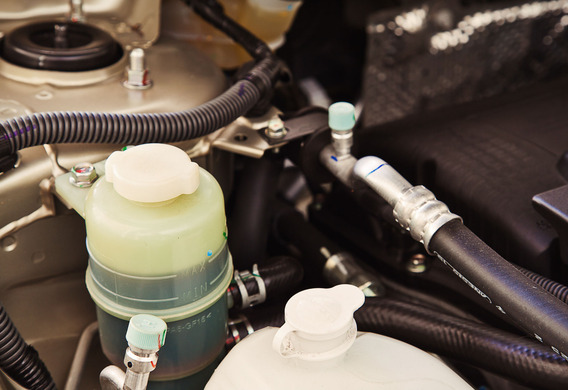
The classification of DOT brake fluids is one of the most important, because it assesses the main characteristics of the quality and the compatibility of the fluids with the vehicle's brake systems.
What is a DOT and which class of liquids to choose?
What is DOT?
Classifications of requirements for brake fluids have been developed by the specialists of the US Department of Transportation, the main expert on transport safety. The jaweed were divided into special classes, each with its own set of properties. Their common name is DOT-reduction from United States Department of Transportation.
DOT is an American standard recognized worldwide
The American requirements, as the most appropriate, have been accepted by the world community and the brake fluids are classified by DOT almost everywhere in the world.
DOT Classes
The main classes are four-DOT 3, DOT 4, DOT 5, and DOT 5.1. There is an additional class-DOT 5.1/ABS-such fluid is suitable for vehicles with antilock system.
In Russia, it is sometimes possible to meet the brake liquids with DOT 4.5 and DOT 4 +, information about the properties of such liquids are in the instructions to them, but these markings are not relevant to the US system.
The composition of the DOT 3, DOT 4, and DOT 5.1 fluids is very similar, all of which are based on glycol and polyester. So the fluids of these classes are, in principle, interchangeable, but of course they have different differences.
DOT 5 is made on the basis of silicone, and DOT 5.1/ABS is made of silicone with the addition of glycols. Therefore, these two types of liquids are not compatible with any others.
What are the different classes?
DOT 3 brake fluid is the simplest compound of glycols. This class of liquids is inexpensive, which gives it popularity.
The liquid of this class quickly absorbates moisture and the boiling point is low after a short period of time. The average service life of such a liquid is less than 2 years. At the same time, the viscosity of the DOT 3 fluids is not the highest for all, at -40 to 1500 mm2/s, which is the average. This class is usually used in cars with drum brakes or with disc brakes on the front wheels. DOT 3 is not compatible with the natural rubber gaskets, and the liquid is aggressive with the paint.
Theoretically, the different brake fluids can be mixed. But you can only pour the liquid into the liquid class in the liquid class below. And by no means the other way around.
The DOT 4 fluid class has improved characteristics. DOT 4 has a hydrochloric acid in addition to the glycols. It is the one that helps to neutralize the extra water in the liquid. This means that the initial boiling point will remain unchanged for a long time, and the liquid will last longer. But the viscosity of liquids of this class is the highest among all classes, and that's what DOT 4 does not perfect. Her composition is also aggressive with the paint.
DOT 4 is used by motorists most often. They are intended for vehicles with disc brakes on all wheels. It's a liquid that's about two years old.

DOT 5.1 fluids have the highest boiling point among the classes, and the viscosity is lowest, allowing the brake fluid to circulate freely through the system and contributes to the best performance of the brakes. That is why the liquid class 5.1 is used in racing and sports cars, as well as motorcycles.
But their service life is not too high-about 1 year, as they absorb moisture quite actively. Like other glycolic liquids, they eat the paint, but the rubber details are not aggressive.
The DOT 5.1/ABS class is designed for cars with anti-lock braking systems as well as for cars operating under severe conditions. The jaweed of this class have a mixed structure. They contain glycol and silicone. This liquid has good lubricating properties, a high boiling point, a specially designed batch of anticorrosive additives. But glycols in the composition make this fluid class hygroscopic, so the lifetime is limited to two years.
With the properties of the silicone they are made of, the characteristics of the DOT 5 liquids are closer to the ideal. Stable low viscosity, high boiling point, excessive moisture, neutral with respect to details of the system from rubber and metal, paint. Besides, DOT 5 has the longest serving four-five years.
The main drawback of this fluid is that the alimic moisture, without mixing with the liquid, can be spawed in the brake system (usually in the lower divisions), at low temperatures to freeze and to interfere with its operation. In addition, this class of liquids has a high degree of saturation of air (aeration). Because of this, the DOT 5 properties are not allowed in machines with the ABS system. The class's jatities, like DOT 5.1, are mainly used in high-velocity vehicles.
Is it possible to mix liquids from different classes?
Glycole-DOT 3, DOT 4 DOT 5.1-can replace each other and mix. But there is a certain rule: the liquid of the class above should be added to the liquid by the class below, this is important.
For example, if the system had a DOT 3 fluid, the fill of DOT 4 or DOT 5.1 would improve its performance and, respectively, the operation of the braking system. If the liquid DOT 5.1 has a class or two liquids, the properties of the liquid may be unpredictable.







